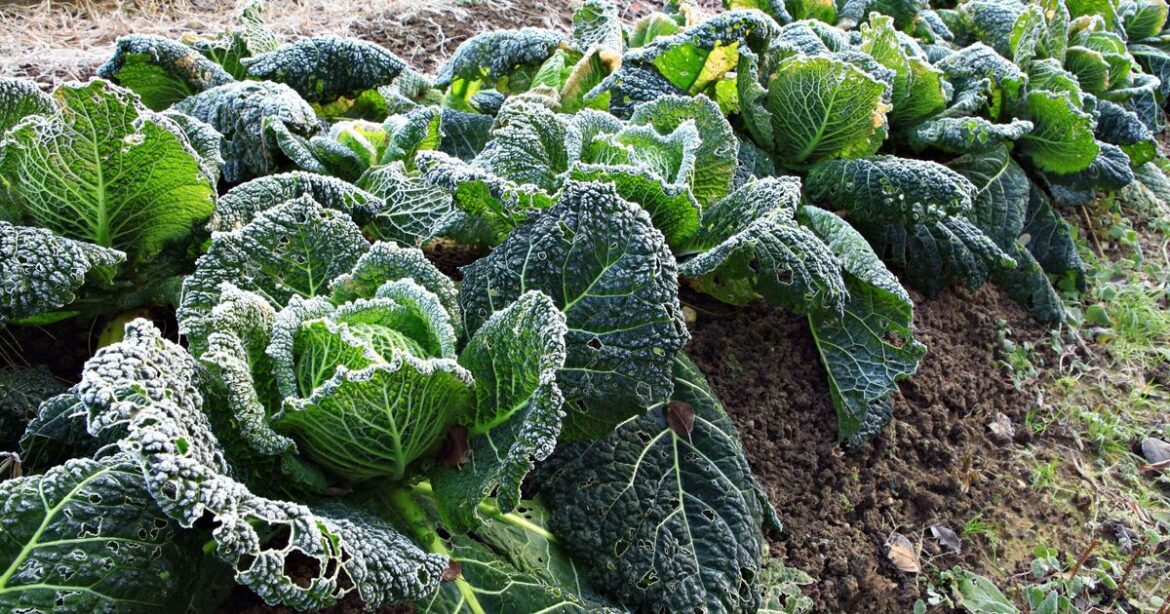As temperatures start to drop and an Arctic blast is set to hit the UK, gardeners are taking measures to protect their produce from the incoming cold months.
On TikTok, RHS-qualified food growth educator Laura – behind the Young Growers Club (@younggrowersclub) account – has an ongoing series explaining how to prepare vegetables for winter in a process called overwintering.
The process aims to protect plants from frost and cold temperatures through methods like moving them indoors, using protective coverings such as mulch, or adjusting their storage conditions.
In her series, Laura takes it a step further and explains how to optimise your timeline and even get early harvests.
Here, we outline the measures she recommends for onions, broad beans, cabbage and garlic, as well as some general advice.
Onions
Laura shows the onions she plans to plant now, leave to overwinter and harvest in summer. “Although onions can be grown from seed, if, like me, you want to overwinter them, we’re gonna use sets to plant them.”
She says to create rows that are 30 cm apart and, in those rows, plant the onions 10 cm apart from each other, with the pointy side facing up and making sure a tiny piece of it sticks out from the ground.
“Once you’ve planted them, I would recommend netting them for a few weeks to protect from birds,” she adds.
As for protecting them from the cold, Laura says: “The only thing I would recommend doing is giving them a good mulch across winter to protect from the colder weather.”
For further safety, she recommends overwintering onions indoors to avoid them getting waterlogged and rotting.
Broad beans
The gardener then shows how she sowed some broad beans in October to be able to get an early harvest in June.
“Make sure you choose a sunny, sheltered spot and then start by creating a staggered double row, making holes about 6 to 7 inches apart.”
“Planting them in a zigzag will mean you can fit more plants into your space, plus the plants will provide each other with a bit of support. If you have enough space, create another double row 60 centimetres apart from the first one, and plant one or two seeds into each of the holes. Make sure the seeds are planted 2 inches deep.”
To help protect the roots from colder weather, she says to make sure you give them a solid mulch with something like grass clippings.
“It might be worth covering them with fleece. When the spring weather comes, the broad beans will really start to come to life. This is when I like to give them another mulch. If you’ve chosen to grow a taller variety, you may also need to stake them with sticks and string.”
Spring cabbage
Laura says it’s too late in the year to grow spring cabbage from seed, but once you’ve got your grown spring cabbage plants ready to overwinter, “you want to choose a site that gets some sunshine during the winter and where the soil is high in nutrients because brassicas are heavy feeders.”
She says to leave 15 centimetres between plants and to give them a mulch once they are in – ideally with grass clippings, as they are high in nitrogen.
“It’s also a good idea to net your spring cabbages as otherwise they’ll make lovely snacks for pigeons. In early spring I will give them a nice seaweed feed and that’s it,” she finishes, saying they’ll be ready to harvest in May.
Garlic
To grow your own garlic while protecting it from the cold, you have two options, according to Laura.
If you have the space, growing it in the ground – in a row, making holes every 15 cm, and then another row 30 cm apart – is the best option. Mulching it during the winter in this case is essential.
If you don’t have much working ground, she recommends growing your garlic in a pot that is at least 15 cm deep, and placing the bulbs 5 cm apart. “Protect it from cold weather and add nutrients,” she advises.


Comments are closed.